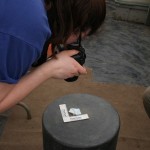As we excavate, part of our job is to screen buckets of soil for artifacts. Normally, the artifacts we find are set off to the side in trays to be counted and bagged at the end of the day. However, if something is unique or especially nice, it is FS’d. FS stands for “Field Specimenâ€, and every time we find an item that we are able to FS it goes through a bit of a process before making it onto our FS Board.
After being uncovered and identified during the initial screening, the artifact goes to be washed (if it can be). We use a wet toothbrush to scrub all of the dirt off and reveal any sort of special markings, etchings, etc.
Once the washing is completed, the artifact needs to be catalogued and photographed. At this point, it gains the official FS number that will be used for future identification and its entry into the Field Specimen Record for Johnson’s Island. We then of write down the artifact and all vital information about it in our Field Specimen form before making a hand drawing for our records. The artifact is then ready to be photographed situated next to a metric ruler for scale.
- Entering information into the official Record
- Drawing FS
- Photographing FS
A small blue tag is filled out with the FS Number, where the artifact was found, and who discovered it; the FS number is also written on the back of the tag. At this point pictures are taken of the artifact with its blue tag and a metric ruler to gauge the size. The tag is placed in a small plastic bag, sealed, and then placed inside a second bag: the one that we ultimately put our artifact in. Once we place our artifact in the bag, we pin it to our FS Board where it will stay for everyone to admire until the end of the day.
At this point in the process the artifact has been FS-ed, and whoever was lucky enough to discover the artifact is given a sticker as a prize from Dr. Bush and then sent back to work. We may only FS one or two items on one day while many more on another, but no matter which way it works out it’s always exciting to see what we have found and lord it over those lacking in reward stickers.
The example FS was a base fragment of a whiteware plate. Base and rim fragments allow us to determine a minimum number of vessels present in a particular archaeological context. Stay tuned for more examples of the FS’s we discover this summer.










Detailed work but fun! Where’s Johnson Island?
It is right off of Marblehead in Northern Ohio.
Johnson’s island is located in Sandusky Bay at the western end of Lake Erie.
which type of archaeological site is this? anyone who can help me out with this? thank you my friends in advance
This is an historic American Civil War prisoner of war depot. There’s quite a bit about the site on the AIA site.
I visited for a day and spent it digging with the people who worked there, I was wondering is FS stood for feces because while I was digging I found mass amounts of ancient feces.
Is there ever any site being worked on the west coast or norther California. I would love to visit and contribute some time to actually working a site. I would love to do something besides reading about other peoples work in a magazine and never see it live or participate in it.